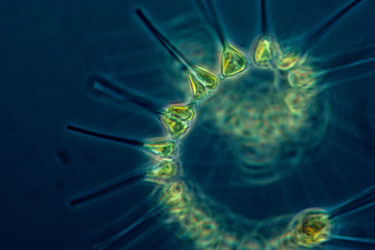How An Algal Metabolic Hack Threatens Our Waters
By Lisa Maria Brand

Algae’s ability to adapt and thrive is bad news for U.S. waterways, highlighting the importance of preventative measures to stave off harmful algal blooms.
Water is a vital resource for life, playing a critical role in everything from our health and well-being to the functioning of the natural world around us. From the smallest microorganisms to the largest animals, all living things rely on water to survive. And yet, despite its importance, water is often taken for granted, and the delicate balance of ecosystems that rely on it is easily disrupted.
Latest Findings
The link between water and humans cannot be overstated. Industry, tourism, fishing, agriculture — all these key industries depend to some extent on access to quality, clean water. The scale of the services we get from waterbodies is hard to comprehend. About 50% of the oxygen we breathe comes from phytoplankton alone, tiny algae that drift in the ocean.
The oceans also play a key role in carbon sequestration, storing about a third of all human emissions by themselves through a series of processes collectively called the biological pump. These tiny algae are the main source of food for countless oceanic species, forming the first level of many food webs and feeding the fish and seafood we all love.
Due to the importance of the ocean in biodiversity and climate regulation, which influence the habitability of our planet, interdisciplinary groups of scientists and industry professionals are working to understand how factors such as climate change and pollution will affect it. And since phytoplankton is such an important piece of the puzzle, a lot of research goes toward understanding what will happen to it. The latest Intergovernmental Panel on Climate Change (IPCC) report states an uncertainty of -20% to +20%, essentially saying that whether we get more or less of it is up to a coin toss.
The Metabolic Hack
Previous models predicted a decline in global plankton by about 8% over the next century. However, scientists have recently discovered that algae are more resilient than previously thought. In a veritable metabolic “hack,” it is able to overcome nutrient shortages expected to occur due to the ocean warming through a process called nutrient uptake plasticity.
As the surface water becomes warmer, it mixes less with the underlying layers, making vital nutrients like phosphate scarcer. And while scientists feared a potential huge decline in phytoplankton production, this may not be the case. How can algae thrive without phosphate? They substitute it — with sulfur. In models that account for this mechanism, global phytoplankton production is predicted to increase by up to 5%.
At first, this seems like a good thing. If phytoplankton gives us oxygen, stores carbon, and feeds fish, this is great news, right? Well, yes and no. While everyone loves positive news and these findings give us a good reason to be cautiously optimistic, there are still problems to consider.
The first issue is that nutrients are not the only factor affecting algae. There are many more mechanisms that could potentially limit this predicted increase. A principle called Liebig’s law says that growth is dictated not by total resources available, but by the scarcest resource. Think of a barrel made of multiple wood planks: the water level is limited by the shortest stave, so even if planktons overcome the lack of phosphate, they can still be harmed by increased acidification, higher temperatures, or pollution.
The Algae Catastrophe
The second issue is that having a lot of algae is not always a good thing. When a stable aquatic ecosystem is affected by a sudden nutrient influx, such as due to agricultural runoff, algae will multiply rapidly and turn into algal bloom.
Depending on the severity, a bloom can block sunlight and deplete oxygen, with disastrous consequences for the entire ecosystem, including mass fish and plant death. Some species even produce dangerous toxins, which can leave local towns and villages without a safe water source and result in fisheries being closed. Algal blooms can even clog dams and impact industrial activities such as mining and hydropower production.
Due to the resilience and capacity to adapt shown by algae, the intensity and number of blooms worldwide have been increasing over the past few decades, and as the climate changes, these blooms are expected to increase by up to 20% over the next century. As some species are quicker to adapt to these new conditions than others, we should expect a shift in the properties of phytoplankton, so we could be underestimating this suspected increase. This metabolic hack that allows them to survive and thrive even in low nutrient concentrations is thus a double-edged sword. Increased carbon storage comes at the cost of both the human economy and ecosystem health.
Preventing HABs
How can we prevent harmful algal blooms? The first step is to address the root causes by directly reducing pollution. Tighter environmental controls are needed to ensure that fertilizers and human and animal waste do not enter oceans or freshwater bodies. Faster and more decisive action is needed to address climate change, one of the main drivers of the increased number of blooms. Lastly, by investing in research and monitoring, algal blooms can be spotted early — and prevented. Innovative technology can now be used to stop the bloom from reaching its peak. For example, ultrasonic devices can prevent algal growth without harming the rest of the environment. We cannot expect to immediately stop all nutrient pollution and reverse climate change, so these devices are a key tool for ensuring the well-being of our waterbodies.
About The Author
 Lisa Marie Brand is a microbiologist with a focus on water quality and algal bloom solutions. With 15 years of experience, she has deep knowledge of algal blooms and their impact on the environment. She is an experienced project manager and has led research projects on freshwater quality analysis and improvement measures.
Lisa Marie Brand is a microbiologist with a focus on water quality and algal bloom solutions. With 15 years of experience, she has deep knowledge of algal blooms and their impact on the environment. She is an experienced project manager and has led research projects on freshwater quality analysis and improvement measures.
